Najpopularniejsze kalibry broni palnej
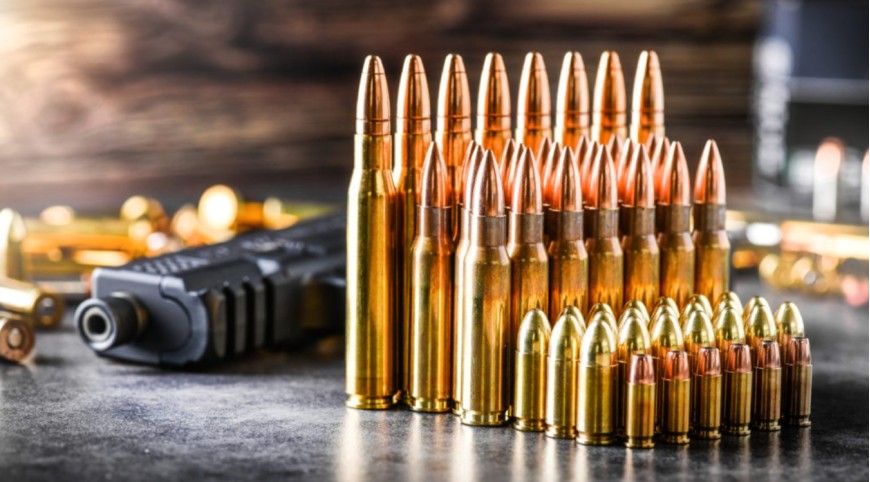
Termin kaliber odnosi się do nominalnej średnicy otworu pistoletu czy karabinu w calach lub milimetrach. Odnosi się to również do średnicy pocisku, a czasem łuski. Naboje amunicyjne są zwykle nazywane po ich kalibrze (średnica). Kaliber jest mierzony za pomocą oznaczeń imperialnych lub metrycznych, w zależności od miejsca produkcji naboju. Na przykład Remington ,223 odnosi się do imperialnej miary konkretnego naboju o średnicy pocisku około 0,22 cala. Metryczny odpowiednik to 5,56 milimetra, a jego konkretna kaseta jest oznaczona jako 5,56x45mm NATO ("45mm" odnosi się do długości obudowy). Oznaczenia kalibrów nie zawsze opisują rozmiary pocisków, a nawet dokładne wymiary. Na przykład średnica pocisku Special .38 wynosi w rzeczywistości .357 cala, podobnie jak Magnum .357 (.38 opisuje średnicę łuski). Pocisk 9 mm (0,35 cala) ma taki sam rozmiar jak .380 ACP.
.223 Remington / 5,56 x 45mm NATO
Jest to nabój centralnego zapłonu kalibru .22, który w 1957 roku został pierwotnie opracowany do nowego lekkiego karabinu bojowego (ArmaLite AR-15). Później stał się amunicją do M16 - standardowego karabinu wojskowego armii USA. Nabój .223 Remington jest jednym z najpopularniejszych nabojów wszechczasów i jest obecnie używany w szerokiej gamie karabinów półautomatycznych i ręcznych. Ten nabój jest szybki, celny i dobry na początek do strzelania z karabinu centralnego lub do samoobrony. Ma dobrą balistykę, lekki odrzut i strzela płasko.
Przykładowe dane
Masa pocisku: 2,27 - 5,8 g (najczęściej 3,6 g)
Prędkość wylotowa: 948 - 1005 m/s
Energia wylotowa: 1786 J
Energia odrzutu: 3,2 J
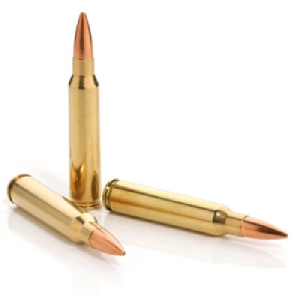
.22 Long Rifle (5,6 × 15 mm R)
.22 LR to nabój małego kalibru bocznego zapłonu. Jest to najczęściej sprzedawana amunicja na świecie, używana w różnych karabinach, pistoletach, rewolwerach i pistoletach maszynowych. Ten nabój został wprowadzony w 1884 roku i został opracowany po .22 Short, który był pierwszym amerykańskim metalowym nabojem zaprojektowanym do oryginalnego rewolweru Smith & Wesson w 1857 roku. Long Rifle .22 jest popularny wśród nowicjuszy i ekspertów ze względu na bardzo niski odrzut i stosunkowo niski poziom hałasu. Jest to niedrogi nabój, w który są wyposażone setki różnych broni. Bardzo popularny w strzelectwie sportowym a także na polowaniach na drobną zwierzynę. To także świetna opcja dla początkujących, którzy uczą się strzelać z karabinu.
Przykładowe dane
Masa pocisku: 1,9 – 3,9 g
Prędkość wylotowa: 110 – 550 m/s
Energia wylotowa: 120 - 275 J
Energia odrzutu: 0,2 J
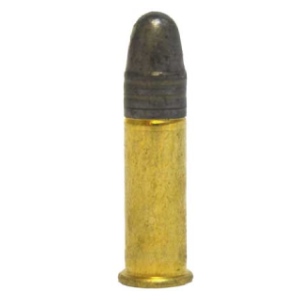
.38 Special (9 x 29 mm R)
Nabój .38 Special to jedna z najpopularniejszych amunicji do rewolwerów, ale jest również używana w karabinkach i pistoletach samopowtarzalnych. Jest to nabój centralnego zapłonu z oprawką, który został wprowadzony przez firmę Smith & Wesson w 1898 roku. Był to również standardowy nabój w amerykańskich departamentach policji od lat 20-tych do 90-tych XX wieku. Był również używany w broni krótkiej przez wojsko USA podczas I i II wojny światowej, wojny wietnamskiej i wojny koreańskiej. Nabój .38 Special jest również określany w innych częściach świata jako 9,1 x 29mm R lub 9 x 29,5mm R. Pojawił się jako ulepszenie naboju .38 Long Colt, którego siła była niewystarczająca dla armia Stanów Zjednoczonych, zmagającej się w walce z Morro Warriors podczas wojny filipińsko-amerykańskiej.
Mimo, że nabój jest określany jako .38, jest bliższy .36, ponieważ ma średnicę pocisku 0,357 cala. Oznaczenie .38 odnosi się do średnicy całej łuski.
W 1934 roku pojawił się następca .357 Magnum, który ma jeszcze dłuższą obudowę, wyższe ciśnienie i doskonałą siłę hamowania kosztem większego odrzutu. Każdy rewolwer kalibru .357 Magnum może używać nabojów .38 Special, niestety nie ma takiej możliwości odwrotnie.
Różnice balistyczne między tymi rodzajami amunicji są następujące:
.357 Magnum:
Prędkość wylotowa: 380-520 m/s
Energia wylotowa: 730-1090 J
.38 Special:
Prędkość wylotowa: 270-350 m/s
Energia wylotowa: 305-450 J
Podobnie jak Magnum .357 wywodzi się z .38 Special przez wydłużenie łuski, .38 Special wywodzi się z .38 Long Colt, który sam wywodzi się z .38 Short Colt.
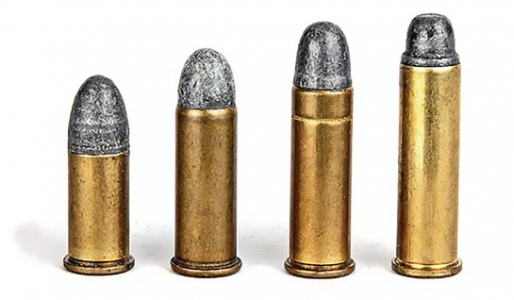
Od lewej: .38 Short Colt, .38 Long Colt, .38 Special, .357 Magnum
.45 Automatic Colt Pistol (.45 ACP)
Amerykański nabój pistoletowy 11,43 × 23 mm zwany jako .45 ACP został zaprojektowany przez Johna Mosesa Browninga w 1904 roku a wprowadzony do uzbrojenia w 1907 roku. Jest przepisowym nabojem amerykańskim od 1911 roku, po wygraniu konkursu na broń krótką przez pistolet Colt M1911 do którego był dedykowany. Nowa amunicja szybko stała się popularna w obu Amerykach. Nabój .45 ACP osiada niższą prędkość wylotową niż nabój 9 × 19 mm, więc lepiej nadaje się do broni wytłumionej, a pełnopłaszczowe pociski kalibru 11,43 mm mają większą zdolność obalającą niż pociski 9 mm.
Przykładowe dane
Masa pocisku: 6 - 15 g
Prędkość wylotowa: 260 - 330 m/s
Energia wylotowa: 477 - 702 J
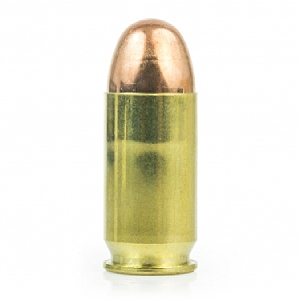
6,35 × 15,5 mm Browning (.25 ACP)
Nabój pistoletowy przeznaczony do zasilania kieszonkowych pistoletów samopowtarzalnych. To prosty nabój pistoletowy centralnego zapłonu wprowadzony przez Johna Browninga w 1905 roku wraz z pistoletem Fabrique Nationale M1905. Nabój .25 ACP stosowany jest w lekkiej kompaktowej broni. Ma stosunkowo krótki zasięg i małą moc, co plasuje go w tej samej klasie co nabój bocznego zapłonu .22 LR, ale przy znacznie wyższym koszcie co sprawia, że jest wypierany przez .22 LR.
Chociaż .22 LR jest nieco mocniejszy, gdy strzela się z dłuższych luf karabinów, to jednak .25 ACP jest postrzegany przez niektórych jako lepszy wybór dla broni ręcznej do obrony osobistej, ze względu na konstrukcję centralnego zapłonu, która jest z natury bardziej niezawodna niż ta z bocznym zapłonem.
Przykładowe dane
Masa pocisku: 3,20 - 3,25 g
Prędkość wylotowa: 230 - 245 m/s
Energia wylotowa: 85 - 95 J
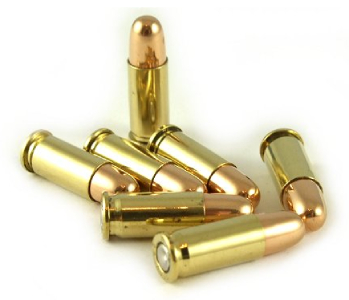
9x19 Parabellum
Parabellum 9×19mm ( znany również jako 9mm Parabellum lub 9mm Luger ) to bezramkowy, stożkowy nabój do broni palnej. Pierwotnie zaprojektowany przez austriackiego projektanta broni palnej Georga Lugera w 1902 roku. Jest powszechnie uważany za najpopularniejszy nabój do pistoletu i pistoletu maszynowego ze względu na niski koszt i szeroką dostępność. Jest to standardowy nabój dla sił NATO, jak również w wielu krajach spoza NATO.
Nabój 9×19mm świetnie nadaje się na dystans lub samoobronę. Ma wystarczającą moc, aby dobrze penetrować z bliskiej odległości, ale nadal łatwo strzelać z niewielkim odrzutem.
Przykładowe dane
Masa pocisku: 6,8 - 8 g
Prędkość wylotowa: 305 - 420 m/s
Energia wylotowa: 584 J
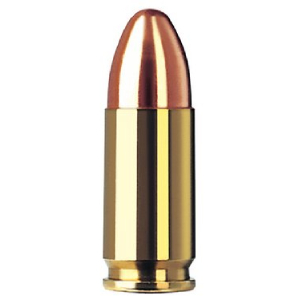
9×18mm Makarow
Nabój 9×18mm Makarow (oznaczony przez CIP jako 9mm Makarow, często też nazywany jako 9×18mm PM ) to radziecki nabój do pistoletu i pistoletu maszynowego. W drugiej połowie XX wieku był to standardowy nabój pistoletów wojskowych Układu Warszawskiego analogiczny do 9×19mm Parabellum stosowanego w wojskach NATO i Zachodu. Nabój 9×18mm został zaprojektowany przez Borisa Semina w 1946 roku, a rok później na bazie tej amunicji Nikołaj Fiodorowicz Makarow zaprojektował pistolet Makarow PM. W 1951 roku zarówno pistolet Makarowa, jak i nabój zostały zaakceptowane przez Armię Radziecką, stąd nabój stał się odtąd powszechnie znany jako Makarow (nie jest to jego oficjalne oznaczenie). Nabój był rozpowszechniony w całym Układzie Warszawskim a po jego upadku stopniowo wycofywany. Natomiast coraz większą popularnością ten nabój cieszy się na rynku cywilnym (zwłaszcza w USA) ze względu na dość wysoką energię wylotową.
Przykładowe dane
Masa pocisku: 6,1 g
Prędkość wylotowa: 310 – 340 m/s
Energia wylotowa: 303 J
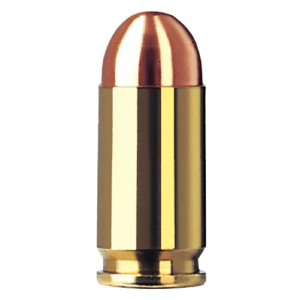
9×18 mm Police
Nabój pistoletowy opracowany na początku lat 70-tych XX wieku w RFN i czasowo wprowadzony na potrzeby policji niemieckiej, dedykowany między innymi do pistoletu Walther PP Super. Wywodził się z przedwojennych prac nad nabojem 9 × 18 mm Ultra, którego rozwój został wówczas wstrzymany. Z upływem lat niemiecka policja ostatecznie zdecydowała się na użycie silniejszej amunicji 9×19 Luger, a 9×18 Police wkrótce poszła w zapomnienie. Nabój został udostępniony na rynku cywilnym w 1975 roku, ale nie zyskał trwałej popularności. Pomimo podobnego oznaczenia do naboju 9 × 18 mm Makarowa, nie jest z nim zamienny.
Przykładowe dane
Masa pocisku: 6,1 - 7,38 g
Prędkość wylotowa: 312 - 360 m/s
Energia wylotowa: 275-324 J
9x17 Short Browning (.380 ACP)
Został opracowany w USA przez Johna Browninga, w celu poprawy skuteczności pistoletu Colt M1903. W USA nabój ten po raz pierwszy został wprowadzony w 1908 roku wraz z pistoletem Colt M1908 a w Europie natomiast około 1912 roku, wraz z innym dziełem Browninga, pistoletem FN Model 1910. Ten nabój jest dostępny w szerokim spektrum ładunków, zarówno z pociskami wojskowymi w płaszczu, jak i bardziej popularnymi ładunkami do samoobrony oraz policyjnymi z pociskami z wgłębieniem punktowym.
Przykładowe dane
Masa pocisku: 5,50 - 6,15 g
Prędkość wylotowa: 305 - 335 m/s
Energia wylotowa: 256 - 328 J
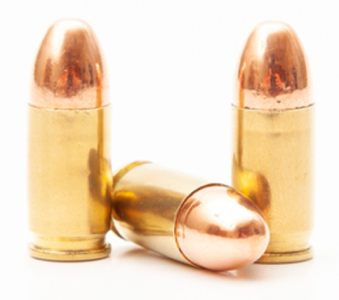




All comments